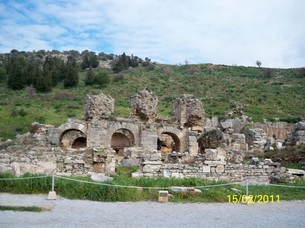 State Baths at Ephesus, Turkey State Baths at Ephesus, Turkey
One of the largest complexes in Ephesus, the Baths of Varius had entrances on the Corobanthies Path and on the Bath's Road.
Why the Baths are called as Skolastika Baths? Upon entering the building you first walk into what was the changing area, the Statue you see inside is of Skolastika and affluent local lady who have had contributed to the renovations of the baths.  Skolastika (Varius) Baths at Ephesus, Turkey Skolastika (Varius) Baths at Ephesus, Turkey
The bath complex was built in the traditional manner.
Unlike the traditional Single-section Turkish Bath near Kusadasi Port, Baths of Skolastika were Consisting of a Frigidarium or a Cold Area, a Tepidarium or warm area, a Caldarium a Hot Area, and a Suditorium a Sauna type section. After this section, visitors would enter to the Suditorium and then move on to the Caldarium to wash and bathe, after which one proceeded to the warm section where one could chat and converse with others. The final stage was Frigidarium where one cooled down in the pool.
If you look closely you will see the sunken area in the ground where the cold pool would have been located.
The baths were fitted with a Hypocaust, a network of clay pipes designed to heat the room by circulating warm air through the walls and along the floor.
The baths was heated in the furnace rooms which could be entered from the academy road.
The baths were not solely a place for washing but a place where one could meet others and spend many hours relaxing and discussing politics, philosophy and other important affairs.
During the Roman era in particular, they were very much in demand.
Some baths had free admission so that the poorest citizens could make use of the facilities. |
